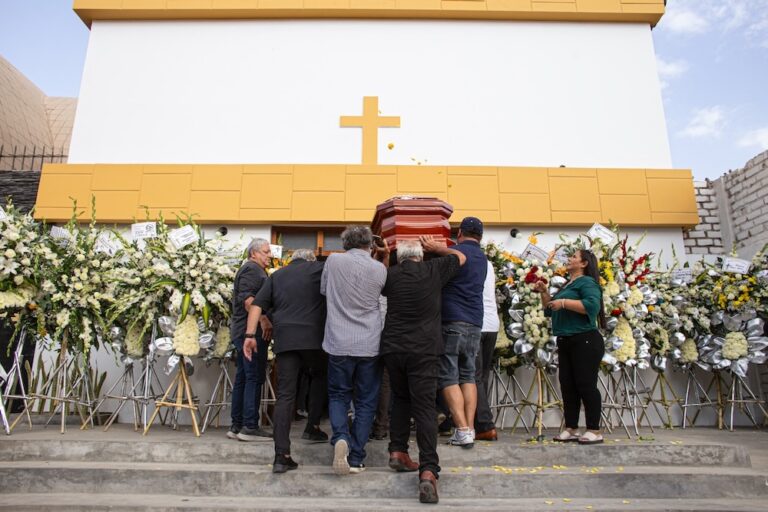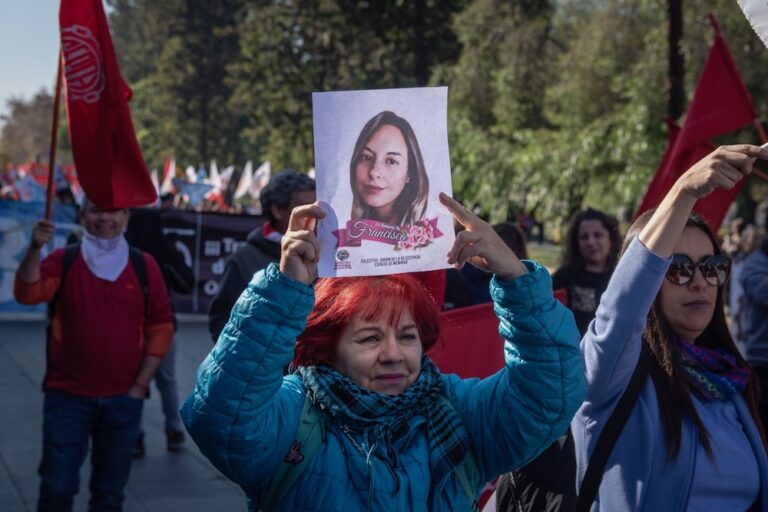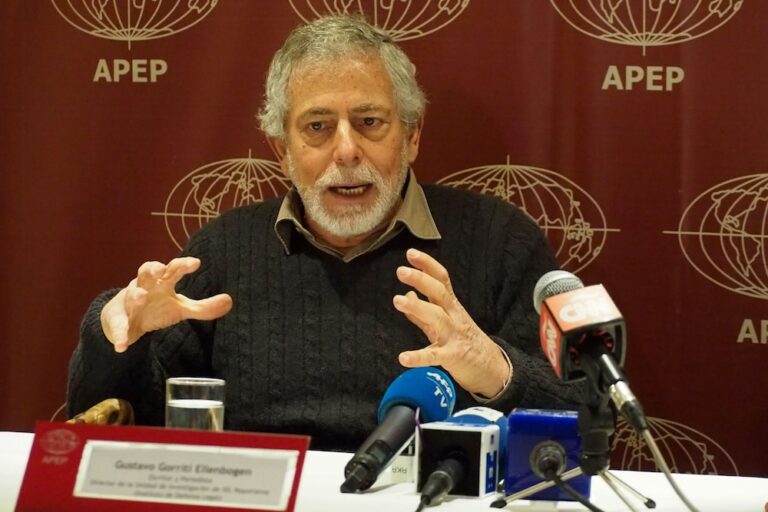Peru’s longstanding battle for press freedom has received little international attention. However, recent attacks may prove that now is the time to take stock of the limitations and threats faced by media workers in Peru.
It was 2 a.m. on April 22 when a masked figure approached the home of Yofré López Sifuentes. Minutes later a bomb exploded, wounding López’s elderly parents and partially destroying his house in Barranca, a port city north of Lima, Peru. This attack marked the 47th violation against a member of the Peruvian press in 2014, according to the country’s National Association of Journalists. Journalists aren’t the only Peruvians being targeted; in 2013, the home of local politician Alfredo Palacios was nearly destroyed in an explosive attack after he made comments alleging that local sugar companies were responsible for environmental contamination.
López is the editor and founder of Barranca, a local newspaper and website, and host of the radio program “Toque de Queda.” He is known for his criticism of local sugar company Agro Industrial Paramonga and of controversial Barranca mayor Romel Ullilén, who he has accused of corruption.
López’s investigations into Agro Industrial Paramonga and its alleged environmental violations landed him in court in 2012, when the company sued him for defamation. López was cleared of all charges when he produced evidence of his findings. If the sugar company had succeeded in silencing López, he would have faced up to three years in jail.
While neighbouring nations such as Venezuela and Colombia fight through high profile struggles with impunity, Peru’s longstanding battle for press freedom has received little international attention. However, these most recent attacks may prove that now is the time to take stock of the limitations and threats faced by media workers in Peru.
In order to understand the state of censorship in Peru, one has to be aware of the country’s history – particularly the internal conflict that scarred the Peruvian countryside from 1980 until 2000. On May 17, 1980, the Communist Party of Peru, commonly known the Shining Path, launched its first violent attack on the Peruvian government, burning ballot boxes on the eve of the first presidential election in twelve years. The Maoist rebel group grew, operating under the goal of replacing the current democracy with a dictatorship of the proletariat.
Decades of violence and human rights violations from both the Shining Path and the Peruvian military followed. From 1985 to 1992, five separate massacres occurred, carried out by both Peruvian military death squads and Shining Path militias. An estimated 70,000 people died between the years of 1980 to 2000. Many of the victims were civilians.
While the Shining Path still exists today, the group’s activity has scaled down drastically, due mostly to dwindling numbers. While Alberto Fujimori, president of Peru from 1990-2000, has been jailed for his part in the human rights violations that took place, the majority of those who perpetrated atrocities as part of the Peruvian military were granted pardons. However, the group Movement for Amnesty and Fundamental Rights (MOVADEF) is working toward freeing those they believe were wrongly imprisoned, including original Shining Path leader Abimael Guzmán. MOVADEF is widely considered to be the political arm of the Shining Path, with the two groups sharing strong ideological and financial links. In addition to campaigning for the freedom of Shining Path leaders, MOVADEF is committed to changing the way the youth of Peru are taught about the conflict, something that has had unexpected consequences for press freedom in the country.
In 2012 a bill was presented to Peruvian congress which criminalized the denial of terrorist activities as an offence punishable by four to eight years in prison. The “Denial Law,” as it came to be known, would penalize those who publicly denied, justified or minimized acts by terrorist groups. As of October 2013 the bill was still awaiting a final vote in Congress.
MOVADEF has consistently argued that the internal conflict of 1980-2000 was a civil war, rather than a government response to a terrorist group. This latter characterization of the Shining Path as a terrorist group prevails in the United States, Canada, and the European Union. It has been reported that the Denial Law was designed to combat MOVADEF and those who would re-write the history of the internal conflict to excuse or diminish the actions of the Shining Path.
The magazine Vórtice became a victim of this censorship when on August 24, 2012, a raid was carried out in its Lima offices. 33 back issues of the magazine were seized on the grounds that it had ties to the Shining Path. Vórtice editor Ronald Cárdenas Loayza had admitted to sharing some of the same ideas as Abimael Guzman.
The “Denial Law” would ostensibly infringe on the Peruvian Constitution, as it guarantees all citizens the right to freedom of expression in any form. Several politicians disputed the bill, including Victor Garcia Tomas, the former head of Peru’s Constitutional Tribunal. Human Rights Watch also issued a statement in 2013 calling for the dismissal of the bill. José Miguel Vivanco, Americas director for Human Rights Watch, warned that “draconian bans may turn bigots into victims, driving them underground and creating a more attractive home for those who are drawn to such groups.”
Despite similarities to laws banning the denial of the Holocaust in other countries, the “Denial Law” lacks the threat of racial violence as support for its validity. On January 17, 2013, journalists and students took to the streets of Peru’s capital, Lima, to protest the law. Oscar Olortegui Chavez, head of Lima’s College of Journalism, spoke out against the law, saying it was a way for the government to “influence their work as journalists.” Chavez explained, saying “They want to control us and we cannot in any way get messed up with seditious actions by Peruvians that mistakenly, at some point, have been against our institutions. Now, we want them to respect our rights for a free press and expression, with dignity.”
In a climate so entrenched in silence, it’s even more disheartening to learn of the recent case in the region of Madre de Dios concerning journalist Manuel Calloquispe Flores. Using his political TV show La Cara del Pueblo and other news outlets, Calloquispe has condemned the environmental damage caused by illegal mining, making enemies out of both illegal miners and fellow journalists.
On March 20, The National Confederation of Artisanal and Small-Scale Gold Miners of Peru called for strikes in response to the national formalization process for miners, launched to incorporate illegal and informal miners into the system. This incorporation would necessitate workers to pay taxes and for companies to file environmental impact statements. In most of Peru the strike ended quickly, following negotiations with the national government. However, in the region of Madre de Dios the strikes continued. It resulted in protests and violence, with many injured and two deaths.
Madre de Dios became the stronghold for the strikes following the government’s crackdown on the region’s fuel regulations. While this was originally done to fight illegal mining operations, the fuel restrictions impeded many other sections of society (tourism, travel, etc.), bringing more people into the protests.
With much of the region opposed to the national government, Calloquispe has found himself practically alone in reporting on illegal activity in the region, and in a climate rife with social and economic constraints, he is being condemned for his work. The dissonance between Calloquispe and his peers appears to stem from an “us vs. them” mentality where Calloquispe is viewed as supporting the government over the people in his region because he’s reporting on illegal activity.
One journalist in particular, Díomedes Maquera Cotrado, has spoken out fervently against Calloquispe’s investigative work and called for the public to drive Calloquispe out of the region. Maquera, alongside fellow journalists Isaac Yabar Irarica and Percy Núñez Sosa, supported the strikes against the fuel restrictions. The three journalists have also accused Calloquispe of “[reporting] against the demonstrators.”
On April 24, Calloquispe formally appealed to the Government of Madre de Dios for personal protection. Calloquispe has suffered greatly in recent months, including being beaten and threatened. His life and wellbeing are in jeopardy, while fellow journalists turn on him and go so far as to call him a “traitor.”
The strikes in Madre de Dios ended in late April after a series of concessions from the Peruvian government. Among other things, President Humala announced a government investment of 100 million soles (approximately $40.2 million CAD) for development in the region. While the strikes may be over, frequent threats and attacks against journalists who report on mining issues, corruption, drugs, and land conflicts persist and must be addressed.
There are many sides to journalism in Peru. Freedom of speech continues to be sought out on a wide and unwavering level, yet there are many hurdles standing in the way of this goal. Journalism in the country is a profession for the dedicated and, increasingly, for the unafraid. And if the issues surrounding freedom of speech are not addressed and corrected soon, journalism will become a profession no one can afford to pursue.
Victoria Quiroz is a final-year journalism student at Humber College.
This article was originally published on cjfe.org on 20 June 2014.


